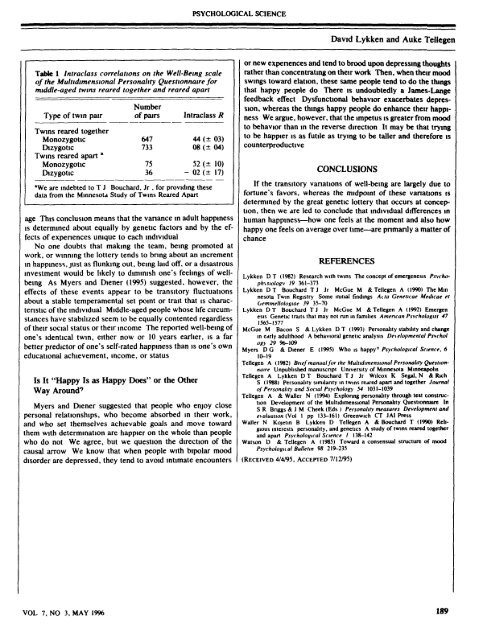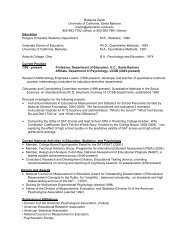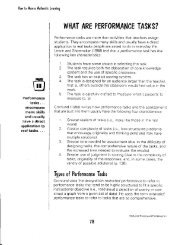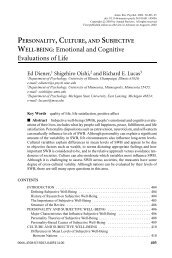happiness is a stochastic phenomenon - Gevirtz School of Education
happiness is a stochastic phenomenon - Gevirtz School of Education
happiness is a stochastic phenomenon - Gevirtz School of Education
Create successful ePaper yourself
Turn your PDF publications into a flip-book with our unique Google optimized e-Paper software.
TaWe 1 Intraclass correlations on the Well-Being scale<br />
<strong>of</strong> the Multidimensional Personality Questionnaire for<br />
middle-aged twins reared together and reared apart<br />
Type <strong>of</strong> twin pair<br />
Twins reared together<br />
Monozygotic<br />
Dizygotic<br />
Twins reared apart *<br />
Monozygotic<br />
Dizygotic<br />
Number<br />
<strong>of</strong> pairs<br />
647<br />
733<br />
PSYCHOLOGICAL SCIENCE<br />
44 (± 03)<br />
08 (±04)<br />
52 (± 10)<br />
- 02 (± 17)<br />
•We are indebted to T J Bouchard, Jr , for providing these<br />
data from the MmnesoU Study <strong>of</strong> Twins Reared Apart<br />
age Th<strong>is</strong> conclusion means that the vanance in adult <strong>happiness</strong><br />
IS determined about equally by genetic factors and by the effects<br />
<strong>of</strong> expenences unique to each individual<br />
No one doubts that making the team, being promoted at<br />
work, or winning the lottery tends to bnng about an increment<br />
in <strong>happiness</strong>, just as flunking out, being laid <strong>of</strong>f, or a d<strong>is</strong>astrous<br />
investment would be likely to dimin<strong>is</strong>h one's feelings <strong>of</strong> wellbeing<br />
As Myers and Diener (1995) suggested, however, the<br />
effects <strong>of</strong> these events appear to be transitory fiuctuations<br />
about a stable temperamental set point or trait that <strong>is</strong> charactenstic<br />
<strong>of</strong> the individual Middle-aged people whose hfe circumstances<br />
have stabilized seem to be equally contented regardless<br />
<strong>of</strong> their social status or their income The reported well-being <strong>of</strong><br />
one's identical twin, either now or 10 years earlier, <strong>is</strong> a far<br />
better predictor <strong>of</strong> one's self-rated <strong>happiness</strong> than <strong>is</strong> one's own<br />
educational achievement, income, or status<br />
Is It "Happy Is as Happy Does" or the Other<br />
Way Around''<br />
Myers and Diener suggested that people who enjoy close<br />
personal relationships, who become absorbed in their work,<br />
and who set themselves achievable goals and move toward<br />
them with determination are happier on the whole than people<br />
ho do not We agree, but we question the direction <strong>of</strong> the<br />
causal arrow We know that when people with bipolar mood<br />
d<strong>is</strong>order are depressed, they tend to avoid intimate encounters<br />
VOL 7, NO 3, h4AY 1996<br />
David Lykken and Auke Tellegen<br />
or new expenences and tend to brood upon depressing thoughts<br />
rather than concentrating on their work Then, when theu- mood<br />
swings toward elation, these same people tend to do the things<br />
that happy people do There <strong>is</strong> undoubtedly a James-Lange<br />
feedback effect Dysfunctional behavior exacerbates depression,<br />
whereas the things happy people do enhance theu- <strong>happiness</strong><br />
We argue, however, that the impetus <strong>is</strong> greater from mood<br />
to behavior than in the reverse direction It may be that trying<br />
to be happier <strong>is</strong> as futile as trying to be taller and therefore <strong>is</strong><br />
counterproductive<br />
CONCLUSIONS<br />
If the transitory vanations <strong>of</strong> well-being are largely due to<br />
fortune's favors, whereas the midpoint <strong>of</strong> these vanations <strong>is</strong><br />
determined by the great genetic lottery that occurs at conception,<br />
then we are led to conclude that individual differences in<br />
human <strong>happiness</strong>—how one feels at the moment and also how<br />
happy one feels on average over time—are pnmanly a matter <strong>of</strong><br />
REFERENCES<br />
Lykken DT (1982) Research with Iwins The concept <strong>of</strong> emergenes<strong>is</strong> Pswhoph\siol<strong>of</strong>!\<br />
19 361-373<br />
Lykken DT Bouchard TJ Jr McGue M & Tellegen A (1990) The Min<br />
nesou Twin Reg<strong>is</strong>try Some initial findings Mta Genelicae Mtdicae el<br />
Lykken DT Bouchard TJ Jr McGue M & Tellegen A (1992) Emergen<br />
es<strong>is</strong> Genetic traits that may not run in famihes Amencan Psycholog<strong>is</strong>l 47<br />
1565-1577<br />
McGue M Bacon S & Lykken DT<br />
in early adulthood A behavioral g(<br />
tm 29 96-109<br />
Myers DG & Diener E (1995) Who <strong>is</strong> happy''PsyrWog/ra/SfK^ncf. 6<br />
10-19<br />
Tellegen A (1982) Brief manual for the Mulndtmensional Personality Questionnaire<br />
Unpubl<strong>is</strong>hed manuscnpt University <strong>of</strong> Minnesota Minneapol<strong>is</strong><br />
Tellegen A Lykken DT Bouchard TJ Jr Wilcox K Segal, N & Rich<br />
S (1988) Personality similanty in twins reared apart and together Journal<br />
<strong>of</strong> Personality and Social Psychology 54 1031-1039<br />
Tellegen A & Waller N (1994) Exploring personality through test construction<br />
Development <strong>of</strong> the Multidimensional Personality Questionnaire In<br />
S R Bnggs & J M Cheek (Eds ) Personality measures Development and<br />
evaluation (Vol 1 pp 133-161) Greenwich CT JAI Press<br />
'aller N Kojetin B Lykken D Tellegen A & Bouchard T (1990) Rebgious<br />
interests personality, and genetics A study <strong>of</strong> twins reared together<br />
and apart Psychological Science I 138-142<br />
'atson D & Tellegen A (1985) Toward a consensual structure <strong>of</strong> nraod<br />
Psychological Bulletin 9S 219-235<br />
(RECEIVED 4/4/95, ACCEPTED 7/12/95)





